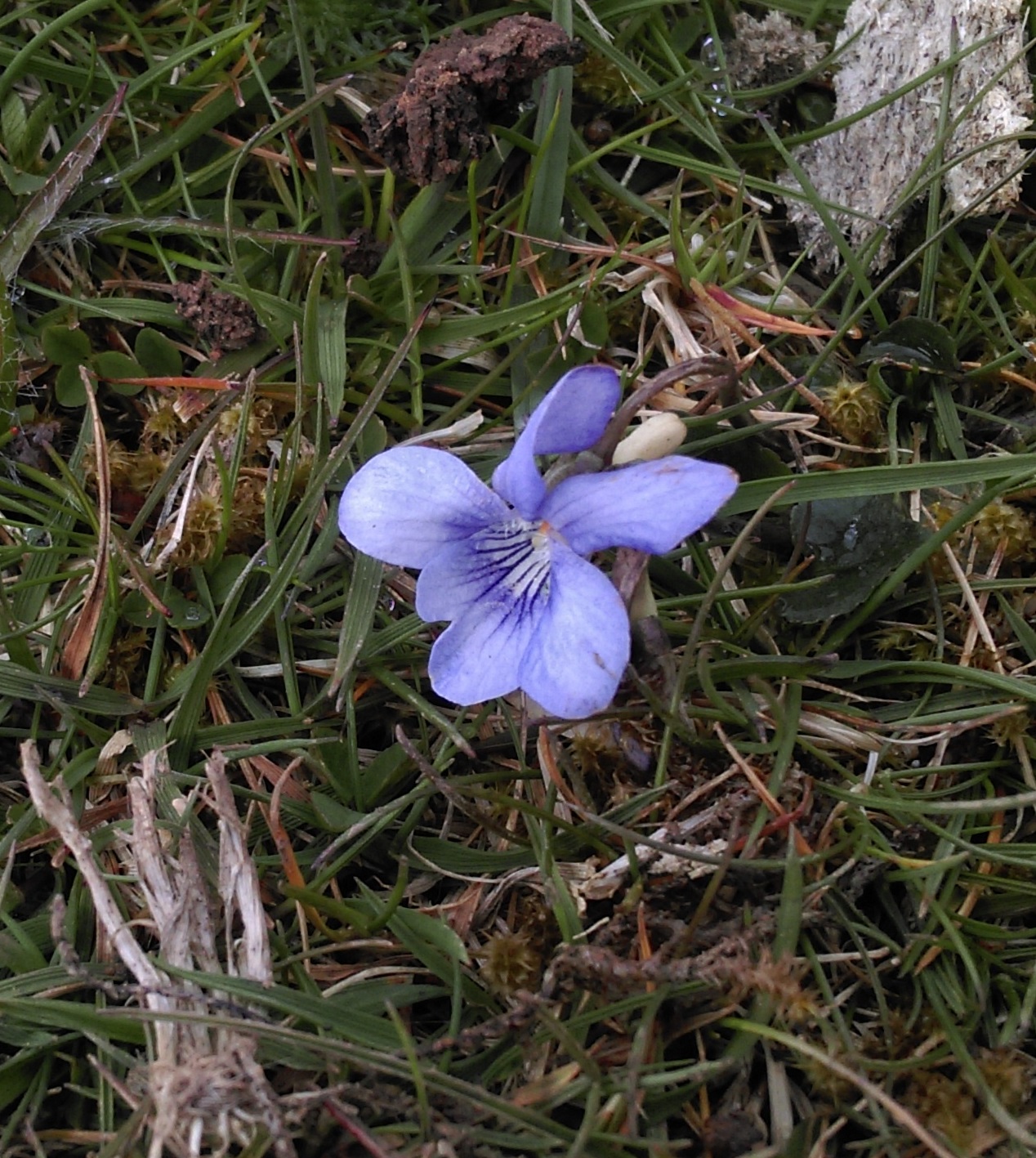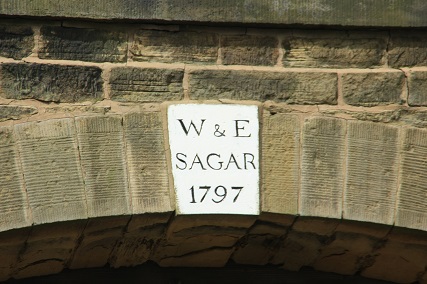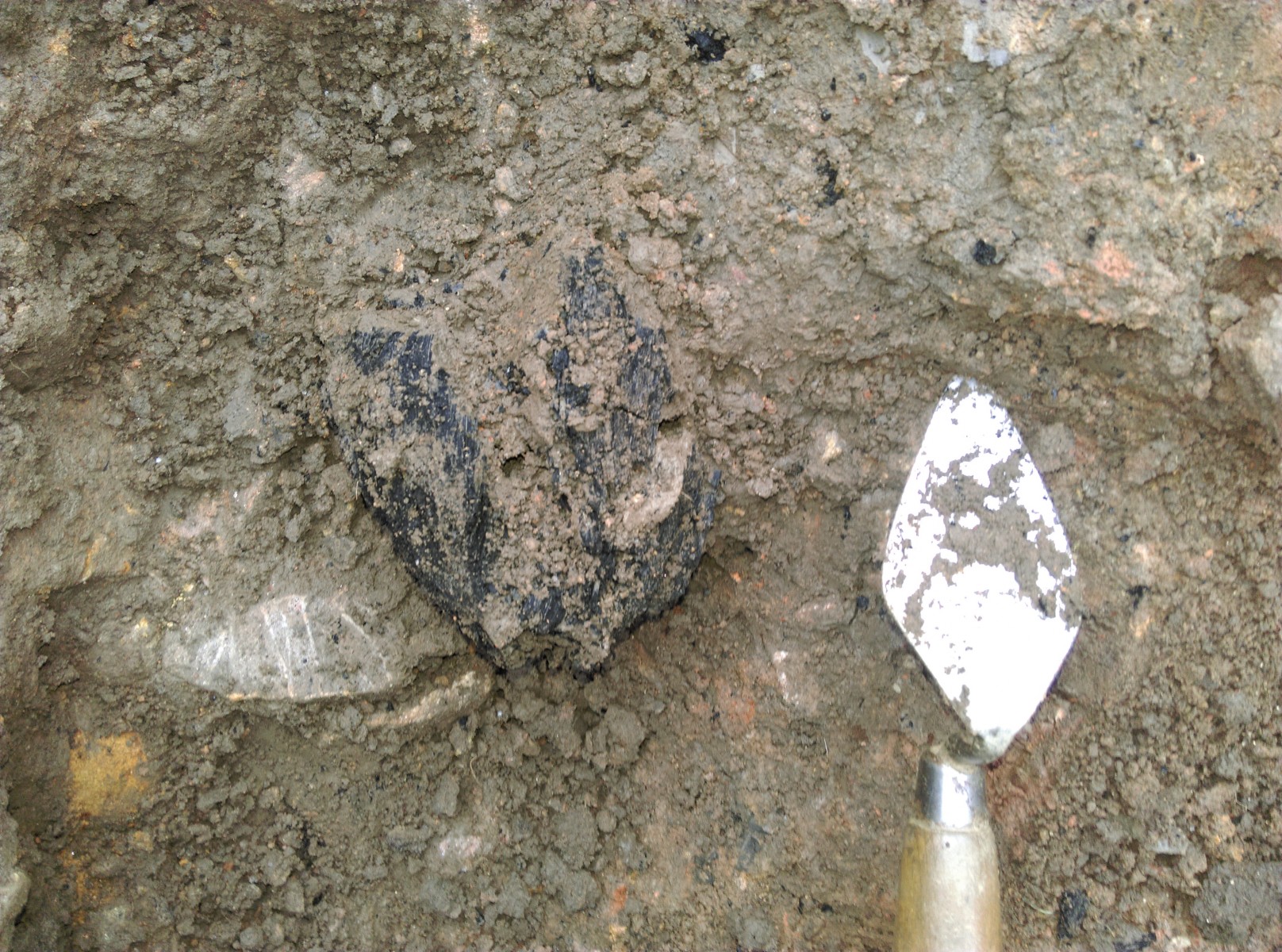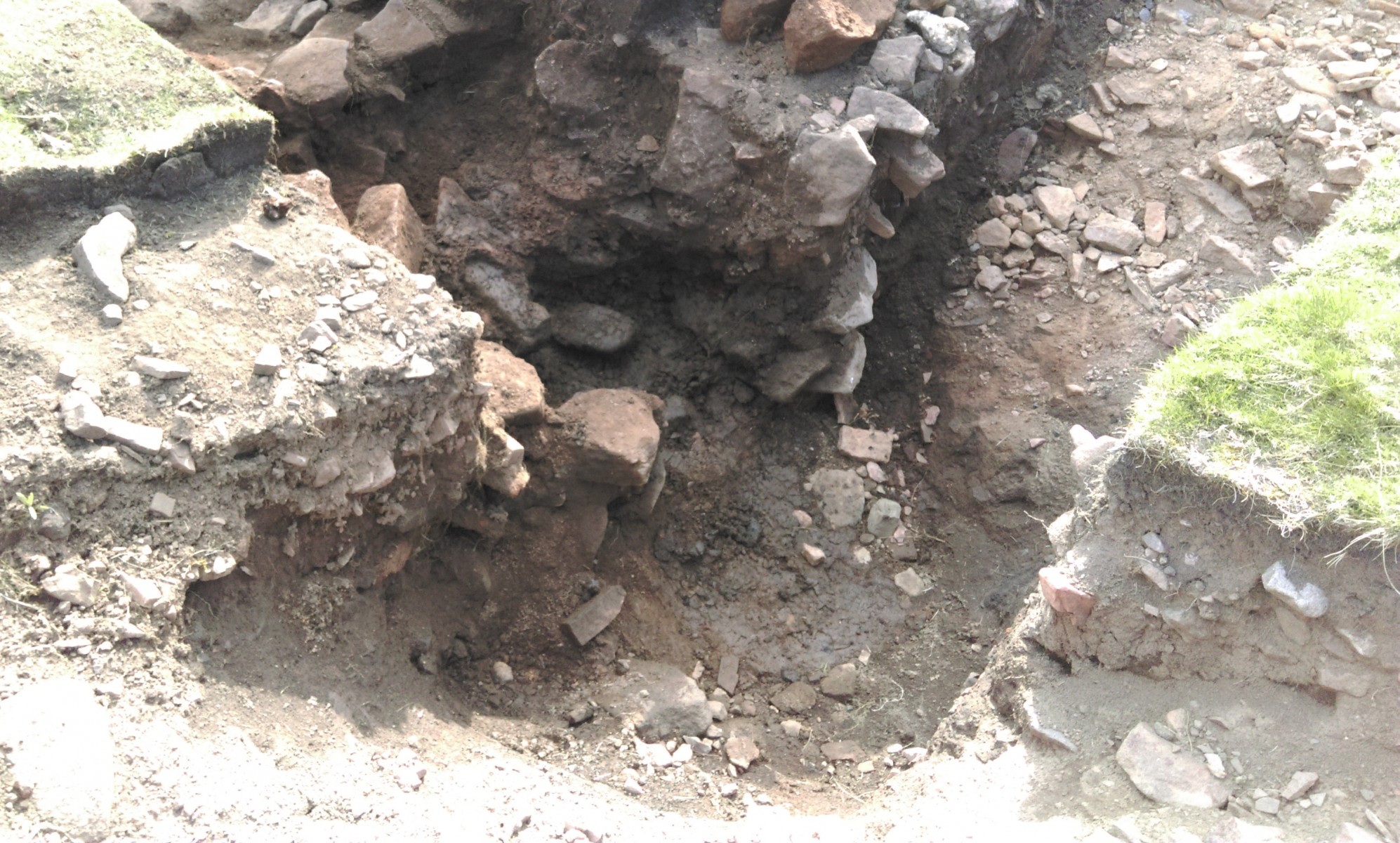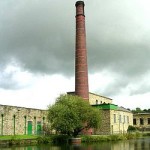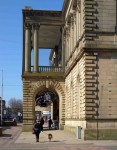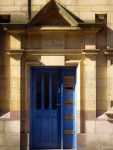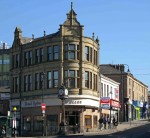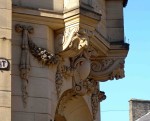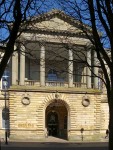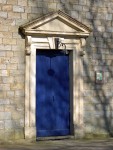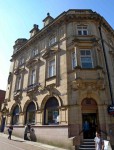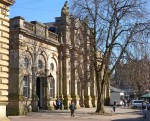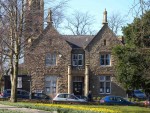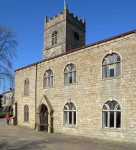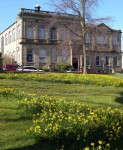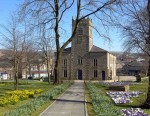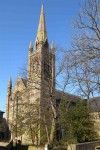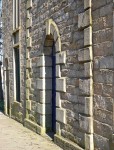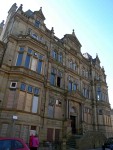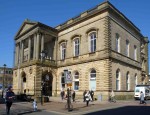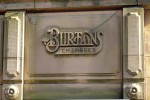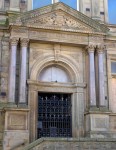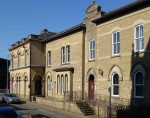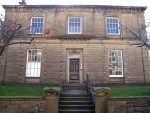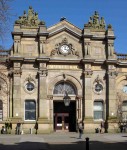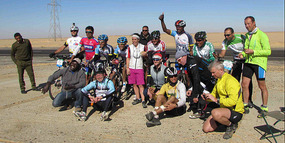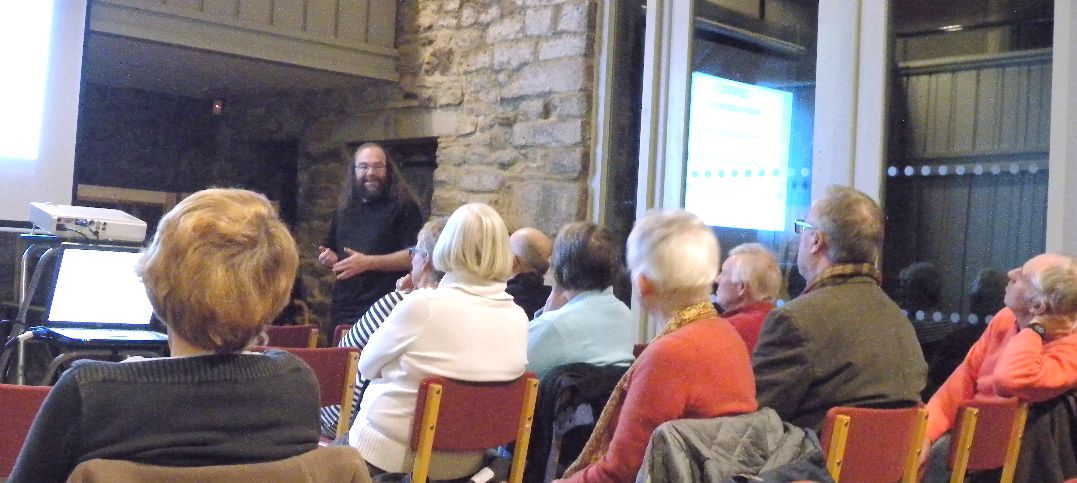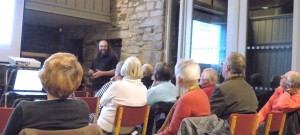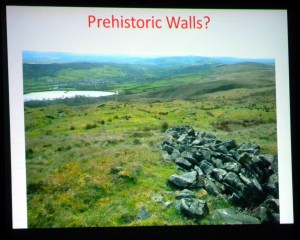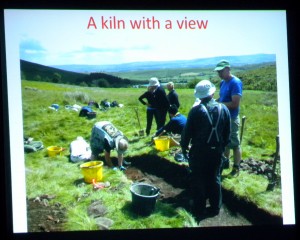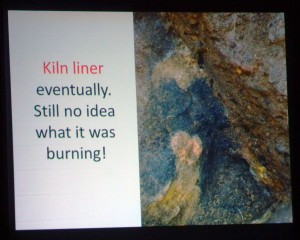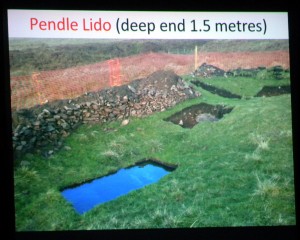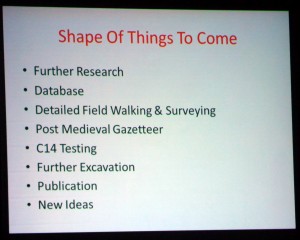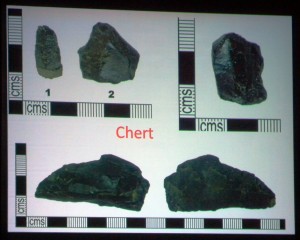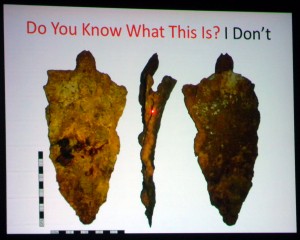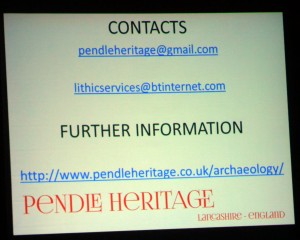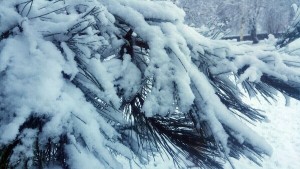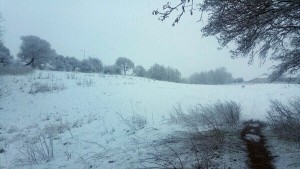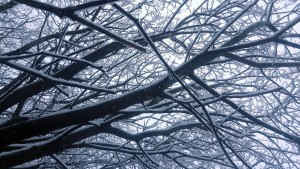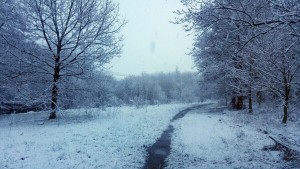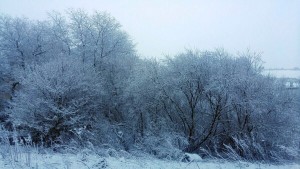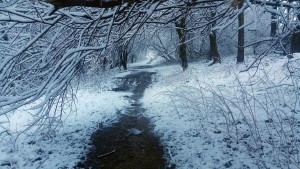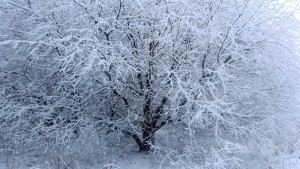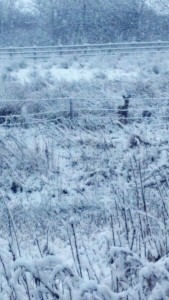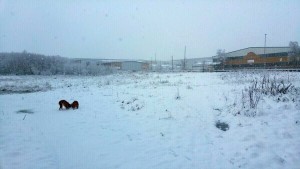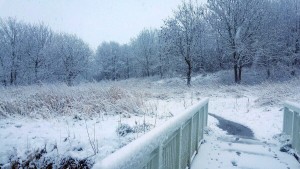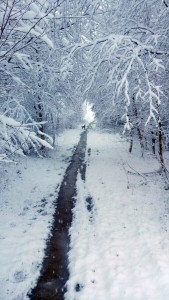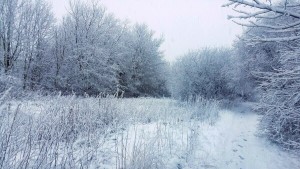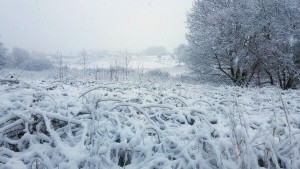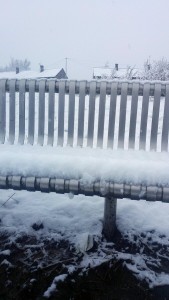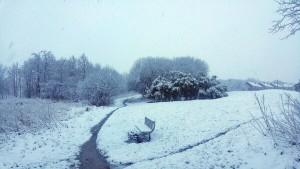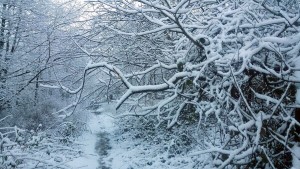Well the kiln dig is finished – well the digging stuff out bit is.
In classic archaeological fashion things revealed themselves as we ran out of time. However what we have found is the bowl & flue from the last firing (see pics), charcoal (hopefully dateable), and a tiny sherd of gritty ware pottery which probably isn’t contemporary.
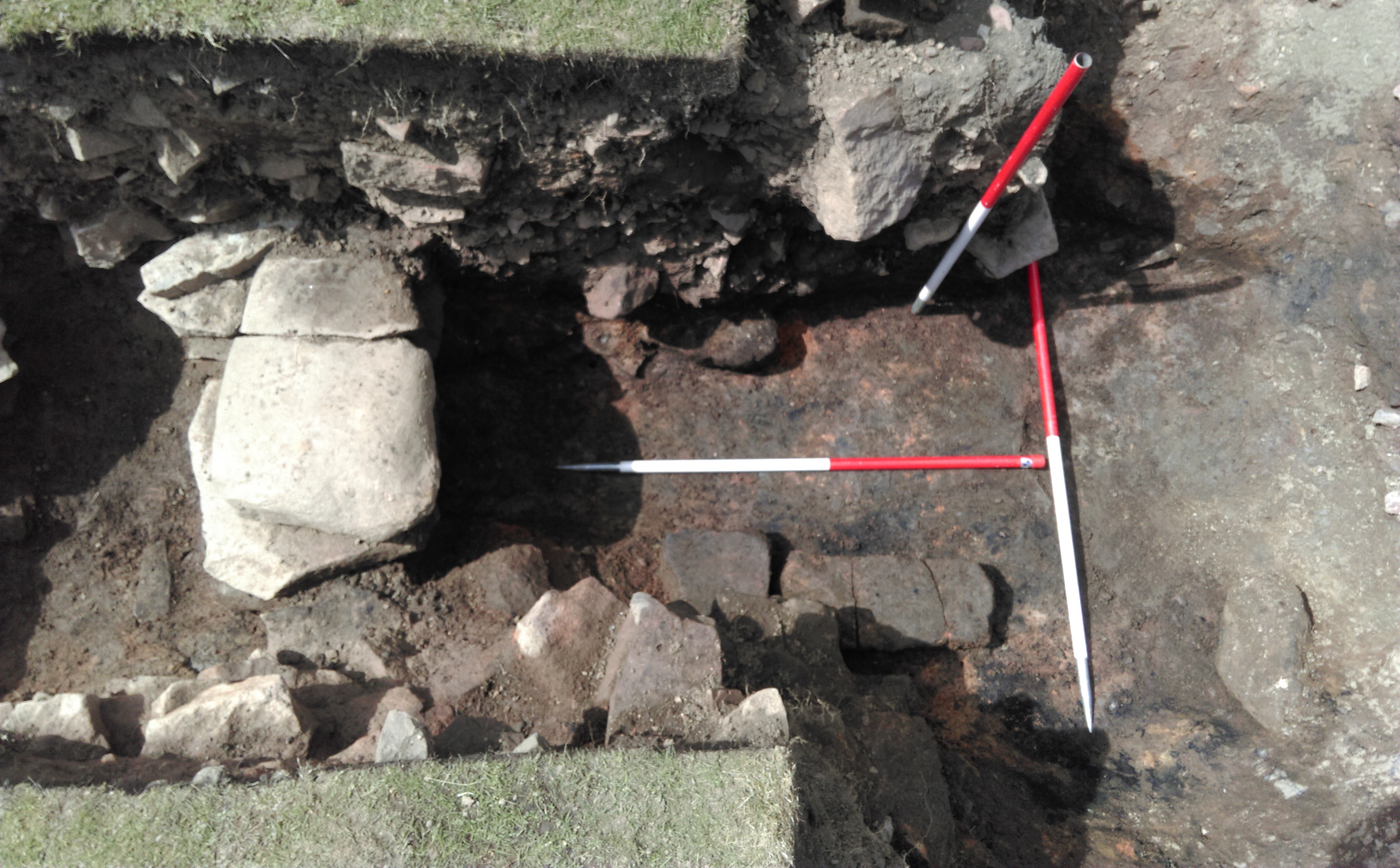
After wind, sleet, hail & snow, our last two days on site were beneath sky like this (from the morning of the last day)
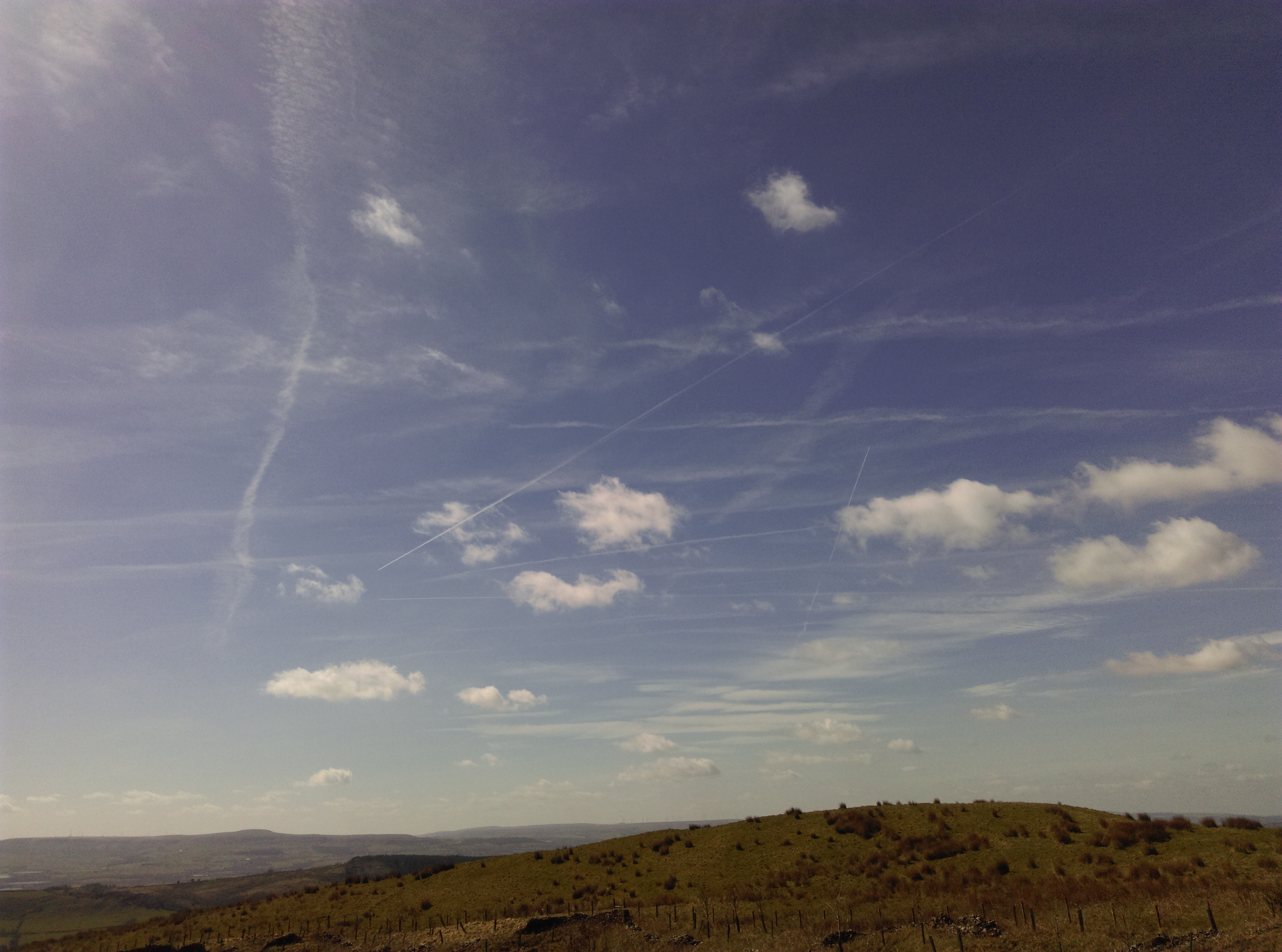
Southfield Methodist Chapel
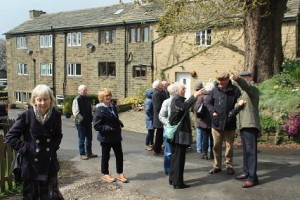 A sudden flurry of snow didn’t deter visitors to Southfield Chapel and hamlet near Nelson organised by The Friends of Pendle Heritage on Wednesday 27th April. Believed to be one of only two remaining chapels of its type, John Wesley preached at this location several times in the late 1700’s whilst visiting his friend William Sagar. William promised to incorporate a Chapel within the barn he was yet to build which was completed in 1797, after Wesley’s death.
A sudden flurry of snow didn’t deter visitors to Southfield Chapel and hamlet near Nelson organised by The Friends of Pendle Heritage on Wednesday 27th April. Believed to be one of only two remaining chapels of its type, John Wesley preached at this location several times in the late 1700’s whilst visiting his friend William Sagar. William promised to incorporate a Chapel within the barn he was yet to build which was completed in 1797, after Wesley’s death.
A most informative talk was given by Mrs Pat Frankland in the 220 year old upstairs chapel where the sounds and smells of the farm were experienced at first hand! A hearty home-made lunch was then served downstairs in a less fragrant atmosphere by ladies of the chapel, with some members being tempted by second helpings!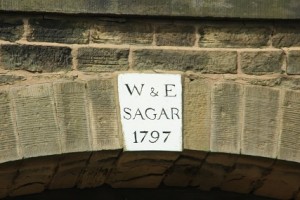
Afterwards the exterior of the buildings in the hamlet were explored with their early datestones and beautiful gardens accompanied by llamas grazing in the field.
One visitor traveled across the border from Ilkley, to visit for the first time the place of his baptism. He enjoyed an emotional reunion with a friend who still recognised him after 79 years!
Craggs Kiln
We have about 10 more days to finish the kiln dig & things are hotting up (relatively speaking).
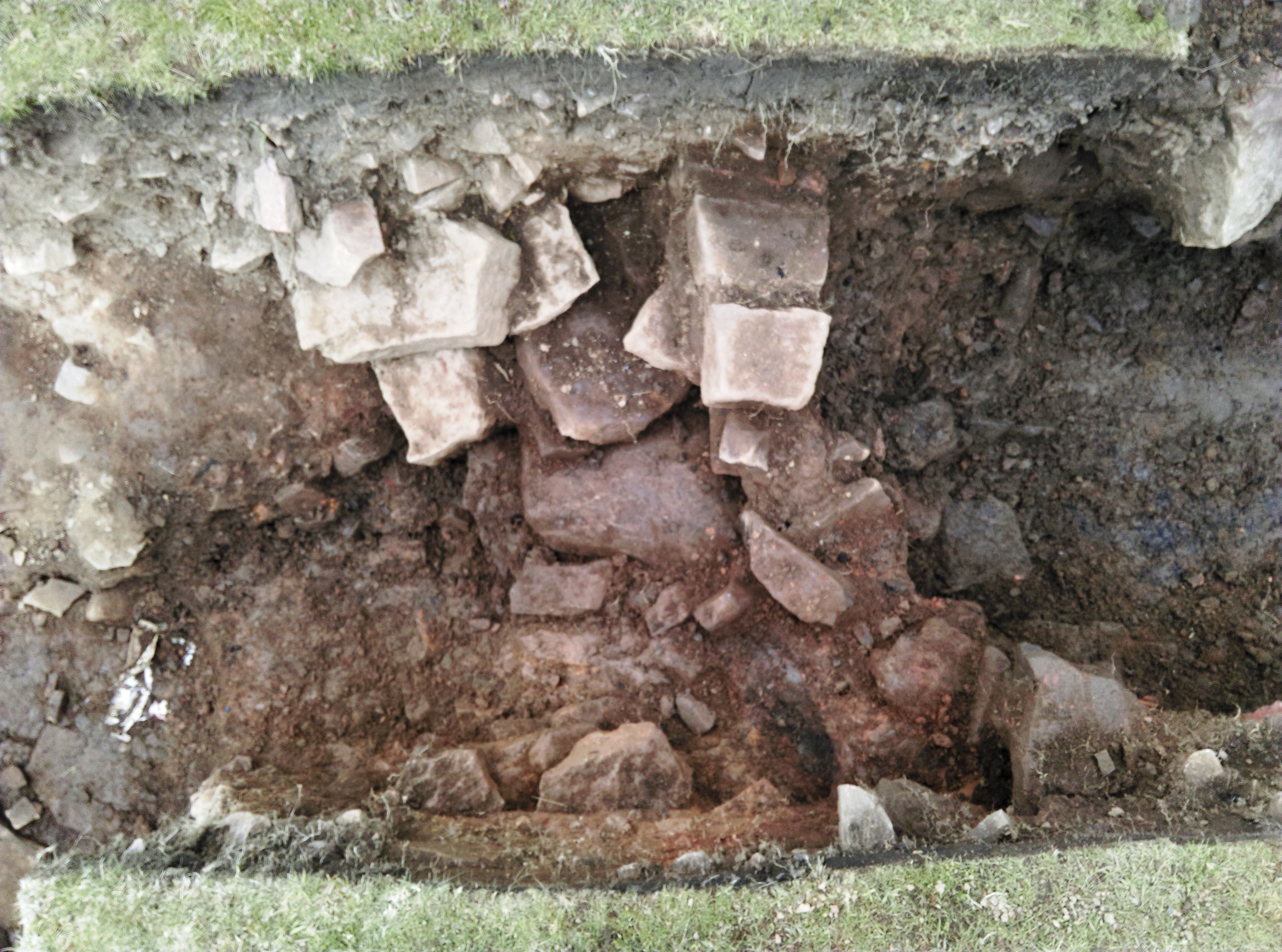
The wall structure (above) seems to have been repaired at least twice. Note colour of the infill either side of the feature. We have lifted a lump of charcoal (below) from the reddish material.
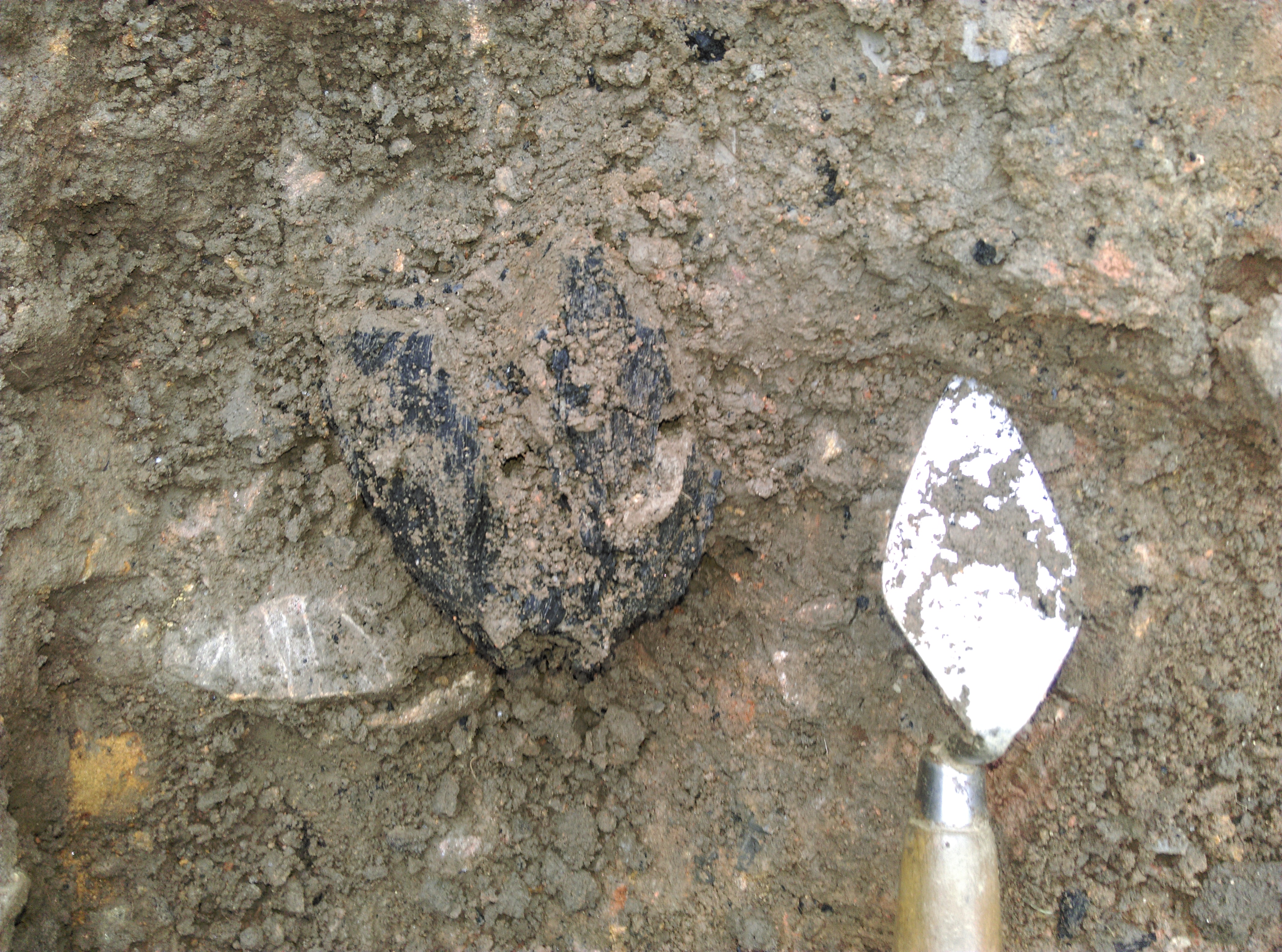
We will be digging every day the weather is reasonable (on site approx 10:45 to 14:00 hours) but please check via email the day before if you want to know if someone will be on site.
Spring Trip to North East
Trip to Alnwick 11/12/13th April 2016
The coach (from Hodgsons as usual but without our usual driver Ian) left promptly from opposite the Malt Kiln in Barrowford at 8.30 am on Monday 11th April.
We drove to Piercebridge where we had coffee/tea and moreish shortbread biscuits at the George Hotel, a 16th century coaching inn. A clock in the George Hotel inspired Henry Clay Work’s 1876 song “My Grandfather’s Clock”. From then on a tall freestanding clock became a “grandfather” clock.
By the river are the remains of the Roman Bridge, part of a large bridge which carried Dere Street, the Roman road, which linked York with Corbridge, across the River Tees. The bridge was wood on a stone foundation. The remains now lie high and dry on the south bank of the river which has moved northwards since the bridge was built.
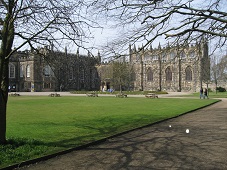 At Auckland Castle we headed for the café for lunch and were pleasantly surprised to find it in a rather elegant library, with waitress service. We were given a conducted tour at 2.00 pm. The castle, which has been owned by the Church of England for more than 800 years, was the former palace for the Prince Bishops of Durham and is still the residence and official headquarters of the Bishop of Durham. Over time the building was added to and altered by a series of Prince Bishops. St. Peter’s Chapel is one of the largest private chapels in Europe and was built by converting a medieval banqueting hall. In the dining room are 12 of the 13 celebrated 17c paintings by Francisco de Durban of Jacob and his sons, which the Church Commissioners wished to sell but these plans were shelved after a donation of £15M from investment manager Joseph Rutter, who also found that his charity, the Auckland Castle Trust, owned the Castle as well!
At Auckland Castle we headed for the café for lunch and were pleasantly surprised to find it in a rather elegant library, with waitress service. We were given a conducted tour at 2.00 pm. The castle, which has been owned by the Church of England for more than 800 years, was the former palace for the Prince Bishops of Durham and is still the residence and official headquarters of the Bishop of Durham. Over time the building was added to and altered by a series of Prince Bishops. St. Peter’s Chapel is one of the largest private chapels in Europe and was built by converting a medieval banqueting hall. In the dining room are 12 of the 13 celebrated 17c paintings by Francisco de Durban of Jacob and his sons, which the Church Commissioners wished to sell but these plans were shelved after a donation of £15M from investment manager Joseph Rutter, who also found that his charity, the Auckland Castle Trust, owned the Castle as well!
We checked into the Hogs Head Inn, Alnwick (named after the tavern in the Harry Potter books)
On the Tuesday we visited Barter Books which is one of the largest second hand book shops in the country sited at the former railway station. Its “Keep Calm and Carry On” poster is one of only two surviving wartime originals, the template for the slogan which you now see everywhere. A model railway runs overhead between the book cases. There is a restored station waiting room used as seating for the café and a huge room lined with over forty glass cases containing many antiquarian books.
We decided not to go to Alnwick Castle gardens because of the heavy rain. Instead we all visited the Castle which is, after Windsor Castle, the largest inhabited castle in England. The Duke and Duchess of Northumberland reside in Alnwick Castle in the winter months, and this is most evident in the Library, created by the 4th Duke in the Prudhoe Tower to house the 14,000 catalogued books in the collection. In addition to the books, the room now contains family photos, a television and a large collection of ingredients for cocktails! The walls of the State Rooms, several of which have been restored by the present Duke of Northumberland, are hung with Italian-style silk (now made in Suffolk) and artworks by masters Titian, Tintoretto, Turner, and there are several paintings by Canaletto. There is a gallery with china which has been collected by the Percy family over hundreds of years. Recently Alnwick Castle featured as Hogwarts School of Witchcraft and Wizardry in the first two Harry Potter films, also as Brancaster Castle in Downton Abbey
In the afternoon there was a coach tour around local sites: Alnmouth, where we didn’t stop, Craster where we visited a café and some bought kippers from the famous L. Robson and Son and finally Seahouses where one could take a boat trip to the Farne Islands, one of the UK’s top wildlife sanctuaries.
On Wednesday we visited the fine prehistoric site at Lordenshaws, an Iron Age fort. It was not easy to find in the mist. It was built at least 2500 years ago and is enclosed by three sets of banks and ditches within which the remains of seven round houses can still be seen. It has two entrances on the east and west sides, each with a holloway leading up to it. On a large rock a hundred yards away were some “cup and rings” carved in the stone.
We spent the rest of the day at Vindolanda where a dig was taking place. There was a model of the site near the entrance. One of the archaeologists gave us an introduction and mentioned the first and only Roman wooden toilet seat ever found! The fort is situated on the Stanegate, the Roman road connecting Corbridge with Carlisle. Construction started in the early 80s which saw the erection of five timber forts leading to the present stone fort which was built in the early 140s. The early timber forts were approximately twice the size of the present stone fort and the famous Vindolanda tablets were found in the earliest of these. On entering the site at the west end you pass into the vicus or civilian settlement and a temple can be seen, also a bath house. Passing down the west street to the fort, on the right is a mansio (an early form of hotel) and on the left a tavern. On the right, entering through the west gate, can be seen the headquarters building, commanding officer`s house and the granaries. To the left can be seen barracks and other buildings. Passing through the fort we walked down the slope to the tearoom and the excellent museum which has been refurbished in recent years. The Vindolanda Tablets were on display and also beautiful jewellery. A whole day would be needed to see everything including watching the volunteers digging in the cold.
We had a comfort and cake stop at Tebay services and returned to Barrowford.
Pendle’s Hidden Valley – Impressions Of The Past
Welcome to the first Pendle’s Hidden Valley blog of 2016. The first fieldwalk – around Admergill (thank you Brian & Richard) – takes place this Saturday & we have already been digging up at the Craggs kiln site. Behind the scenes things have been happening too. Lynn H has been doing sterling work raising funds & working with David T and others on a database. Gayle & Janet have been trawling the reference libraries for clues. Paul & I have been doing mid week forays with Dot the chert hound into the hills while the vegetation is down. Now back to the dig. In the last week we have joined the top & middle trenches. As usual no questions have been answered yet but more have been raised. We have made a few interesting discoveries.


Firstly the wall above – 3 courses deep so far & 5 pieces of charcoal recovered. Secondly another wall (2) – pictured below – where another piece of charcoal was found. This takes the total tally so far to 8. Thanks to a generous grant from the Robert Kiln Trust we will be able to submit some of these for C14 dating.


Finally, near close of play today – we uncovered what appears to be a heel impression (below) in a clump of clay fill between the two walls. The second of the two pictures below shows the impression clumsily outlined in yellow. It would appear to be from a right foot, 50mm across (my size 10 is 65mm in the corresponding place), and either a bare foot or one with an item close fitting footwear. There is a series of lines in the impressed material. Given that this later group of charcoal pieces come from above this heel print we may have discovered Pendle’s oldest human footprint so far.
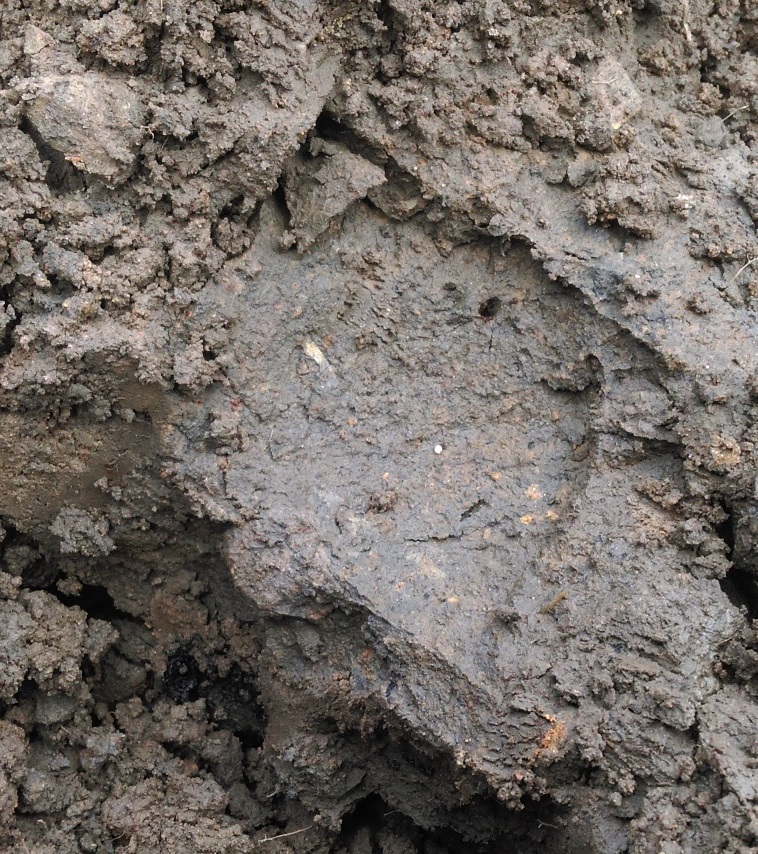
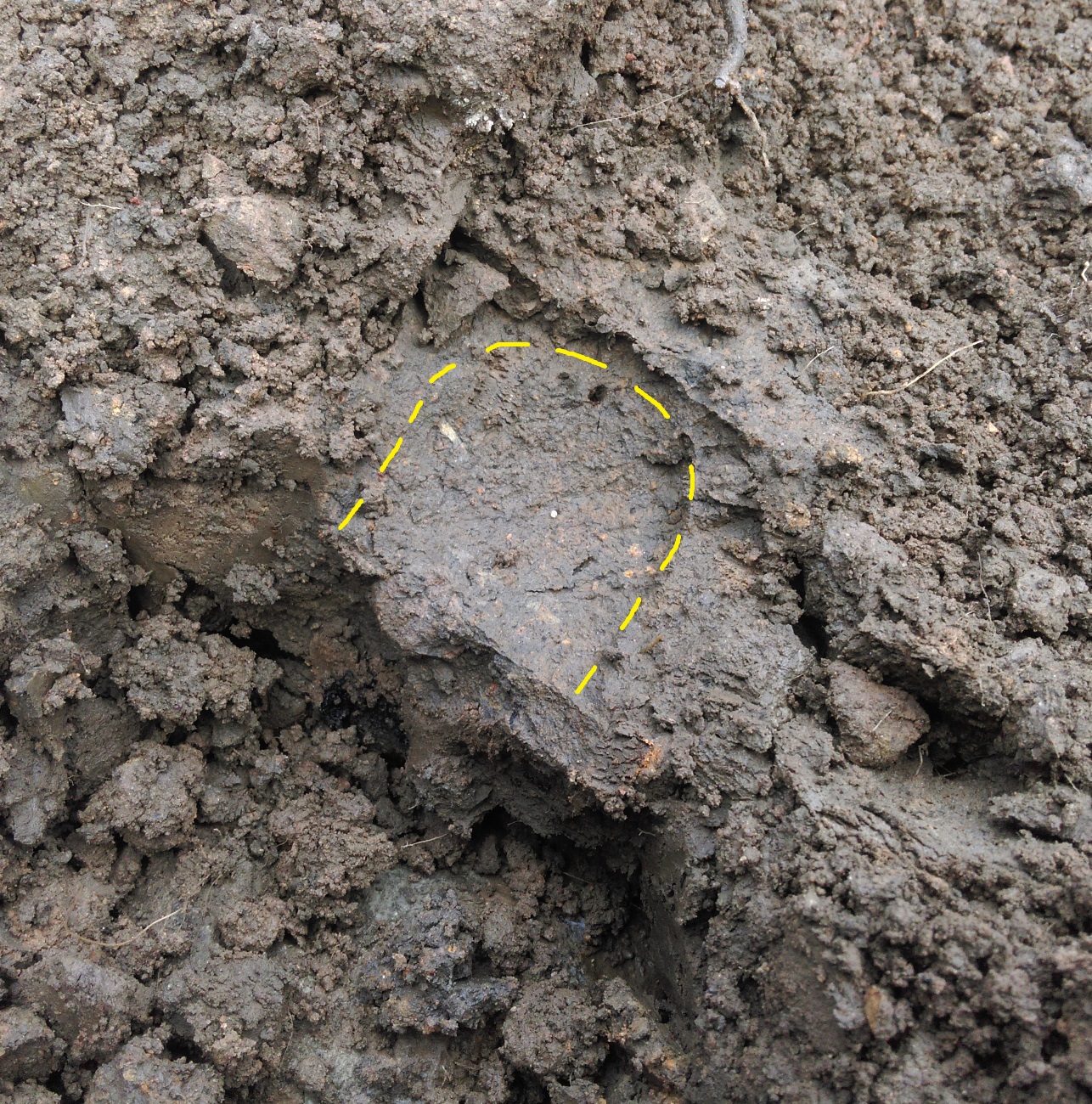
If you want to join us in any capacity please contact us. We will be onsite at the kiln for another week (at the whim of the weather) after which it will have to be back filled. There will be further digs this year at Craggs, mostly near the site of Great Craggs (a far less strenuous walk in) and there will be a week long excavation at the end of May and into June. No experience is necessary as we can give you training on site (non digging roles are available – and essential). Don’t be shy and keep an eye on the events calendar. Alex Whitlock 21 April 2016
Pitches Available for Barrowford’s Market Day
Work gathers pace on £32m. historic mill transformation
Work gathers pace on £32m. historic mill transformation
Click Here for the latest on the Brierfield Mills regerneation prject.
Digging for Britain – Ribchester
Digging for Britain – Ribchester
Last Night’s Digging for Britain programme on the BBC included an archaeological dig in Ribchester which uncovered evidence of the immediate post-Roman period. It also featured Pendle Heritage member Paul Hickman in excavating mode.
Reprieve for Lancashire’s under-threat council museums
Newhallhey vaccary fieldwalk – 12/3/2016 A walk with two puzzles.
Newhallhey vaccary fieldwalk – 12/3/2016 – A walk with two puzzles
Download the report here…
Gardening Group Meet Up 16th March
Gardening Group Meet Up 16th March
Due to many people being committed elsewhere, it was a quiet session in the walled garden scraping the moss from the beds and doing odd jobs. It was quite cold but you can see the plants slowly coming to life. The box edging around the beds, suffering from box blight, seems to be responding to the treatment given to it last year.
The next meeting will be Wednesday 20th April.
Accrington in the Sunshine
Tour d’Afrique
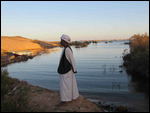 How often do you hear a comment from the audience like ‘I don’t want this talk to finish!’ Well, that’s exactly what happened when Sue Shuttleworth stood up to talk about her year in the saddle. Entitled ‘Tour d’Afrique’, Sue’s talk was delivered in a modest manner even though she’s cycled 27,000kms over the last 12 months across Africa and South America! Beautiful slides, human anecdotes, fascinating historical facts and political asides had the audience gripped from start to finish.
How often do you hear a comment from the audience like ‘I don’t want this talk to finish!’ Well, that’s exactly what happened when Sue Shuttleworth stood up to talk about her year in the saddle. Entitled ‘Tour d’Afrique’, Sue’s talk was delivered in a modest manner even though she’s cycled 27,000kms over the last 12 months across Africa and South America! Beautiful slides, human anecdotes, fascinating historical facts and political asides had the audience gripped from start to finish.
The tour started in Cairo, with cyclists from all over the world meeting for the first time and weighing each other up whilst pondering what lay ahead. Using the coastal route for safety and camping out each night, the group headed South through Egypt supported by two vehicles – one to prepare lunch and one dinner. With distances of 120kms per day commonplace and mountains roads (tarmacked and empty at this stage thanks to Chinese investment) the group took in many of the sights any visitor to Egypt would want to see – the pyramids, Luxor, Abu Simbel etc.
Sue then went on to discuss the Nile, the countries through which it travels and the implications of the Aswan dam on neighbouring states. We were then transported to Sudan to arrive in Khartoum the location of the famous seige in General Gordon lost his life. Unfortunately we had to finish there but there was overwhelming agreement that we should invite Sue for part 2 – not to mention 3, 4 etc!
Keep an eye on our events calendar for details of the next instalment!
Fire at Wythenshaw Hall, Manchester
Fire at Wythenshaw Hall, Manchester
CLICK HERE for latest report and video.
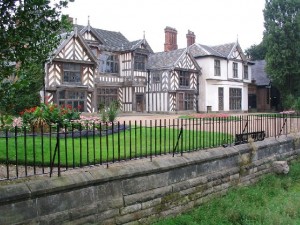 © Copyright Dave Smethurst and licensed for reuse under this Creative Commons Licence
© Copyright Dave Smethurst and licensed for reuse under this Creative Commons Licence
Two men stumble across ‘very, very rare’ Bronze Age burial site
Two men stumble across ‘very, very rare’ Bronze Age burial site
It’s in Lancashire… but they don’t say where… CLICK HERE
Canal milepost restoration appeal
Canal milepost restoration appeal
A major fund-raising appeal has been launched to restore or replace every mile marker along the length of the Leeds and Liverpool Canal – all part of the canal’s 200th anniversary celebrations. Click Here for more…
Pendle’s Hidden Valley – illustrated talk by Alex Whitlock
Alex gave an excellent talk and update this evening about the Archaeology Group’s Hidden Valley Project. The Hidden Valley runs from Sabden area through to Blacko and is hidden by Pendle Hill to the north and the much lower Padiham to Barrowford ridge to the south. Alex concentrated on the activities, finds and discoveries of the last year and it was striking how great a timescale is represented in the valley, from Mesolithic finds through to World War Two structures. The audience entered into the fun of discovery, trying to work out what certain objects and structures were actually used for. All sorts of activities took place in the valley and we were treated to Tudor era quarrying, Napoleonic Yeomanry Musket Practice and prehistorical knapping sites, to name three before Alex looked forward to this year’s activities. Here are one or two of the many slides…
Beautiful images highlight extensive refurbishment at Gawthorpe Hall
Beautiful images highlight extensive refurbishment at Gawthorpe Hall
CLICK HERE for Lancashire Telegraph article.
Snowy Arran Nature Trail, Blackburn/Oswaldtwistle – Photos by Joe Morris
Historic mill and cottages to be bulldozed
Historic mill and cottages to be bulldozed
Another loss to Burnley’s Weaver’s Triangle – click here for details.

